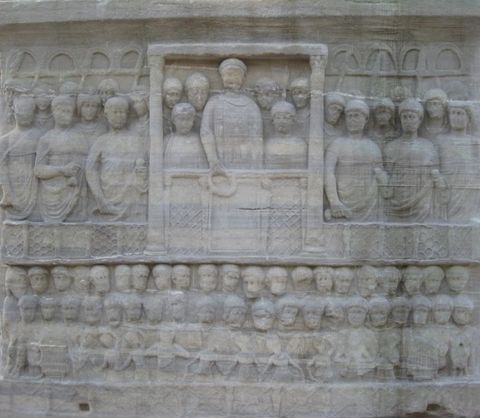Where Sports and Politics Met
Chariot Racing in the Byzantine Empire

(Diesen Text auf Deutsch lesen)
In the sixth century, Roman-style chariot racing was the Byzantine (or Eastern Roman) Empire’s most popular spectator sport, having outlasted the infamous gladiatorial fights and wild beast hunts of the earlier imperial period. The rules of the sport remained essentially the same. The standard race would have been quite familiar to modern observers, with starting boxes and a finish line. There were many variations to keep the races fresh. A particular favorite was the diversium, in which the winning charioteer exchanged horses and chariots with a losing charioteer, and then raced again. Victory in this rematch would prove that the originally victorious charioteer won because of his skill, not because of his horses and equipment. The imperial government administered and financed four racing teams (Blue, Green, White, and Red), which owned the horses and equipment and employed the charioteers. Byzantine chariot races took place in large arenas known as hippodromes. In the fifth and sixth centuries, the heyday of Byzantine chariot racing, hippodromes dotted the lands around the Eastern Mediterranean.
After the sixth century, chariot racing declined in the Byzantine world generally, in large part because it had become intimately connected to government finances. The Byzantine government experienced significant setbacks in the seventh century with the Persian War and the subsequent Arab invasions. The resulting financial difficulties probably led to the disappearance of racing in provincial cities, which we cease to hear about in the seventh century. However, chariot racing and the racing teams definitely survived in Constantinople in diminished form until at least the twelfth century. The attack of the Fourth Crusade in 1204 probably played a role in its eventual disappearance, although chariot racing had probably already been in decline in the years leading up to that event.
It is likely that the emperors preserved chariot racing in Constantinople not just because it made for good entertainment, but also because the races provided an opportunity for the people and emperor to have some face time with one another. The emperors regularly attended the races, as of course did a great many citizens of Constantinople. It is estimated that the hippodrome could hold 100,000 spectators, so this was the largest setting for imperial interaction with the people of the city. In general, it seems that emperors appearing in the hippodrome had an expectation (or perhaps merely a hope) that they would be cheered or otherwise supported by the spectators gathered there. For example, in 602 the emperor Maurice used heralds to address the crowd in the hippodrome and assure them that the revolt of Phocas was not serious. He then ordered a series of chariot races to amuse the assembled people. The fans of the Blues responded by leading a chant in support of Maurice, assuring him (falsely, as it turned out) that he would overcome his enemies (Theophylact The History 8.7.8–9). This is an indication of the way that emperors hoped to use the circus racing factions to their political advantage.
Of course the spectators themselves did not merely show up to support their emperor. They frequently hoped to make requests of the emperor for the improvement of some aspect of their daily lives. These requests could and sometimes did relate to chariot racing itself, as when racing fans of all four colors shouted for the famous charioteer Porphyrius in the hopes that he would be assigned to race for their team. Requests ranged far beyond racing, however. In 512, the people in the hippodrome protested against the emperor Anastasius and shouted for his ecclesiastical advisors to be thrown to wild beasts. Anastasius responded by appearing in the hippodrome without his crown, promising to do everything the people asked, and swearing to abdicate if they wished it. This response pacified them and they acclaimed Anastasius and left peacefully (John Malalas Chronographia 16.19). So in the heyday of Byzantine chariot racing, the spectacle was not merely a form of entertainment, but a forum for discussion between emperor and people. Both hoped to get something from the exchange. A chariot race was the emperor’s chance to speak with many of his people at once, and the people’s chance to confront the emperor directly on their terms with relative anonymity. These exchanges were an essential part of the give and take of government in Byzantium, and they took place in the hippodrome, before, after, and even during the races.
David Alan Parnell, 13. Oktober 2017
David Alan Parnell is Assistant Professor of History at Indiana University Northwest
Suggestions for further reading:
Alan Cameron, Circus factions: Blues and Greens at Rome and Byzantium (Oxford, 1976).
David Alan Parnell, “Spectacle and Sport in Constantinople in the Sixth Century” in Companion to Sport and Spectacle in Greek and Roman Antiquity, edited by Paul Christesen and Donald Kyle, Malden 2014, pp. 633–645.